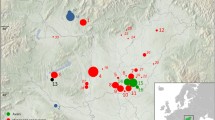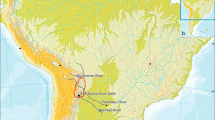Abstract
We applied ancient DNA methods to shed light on the origin of ancient Hungarians and their relation to modern populations. Hungarians moved into the Carpathian Basin from the Eurasian Pontic steppes in the year 895 AD as a confederation of seven tribes, but their further origin remains obscure. Here, we present 17 mtDNA haplotypes and four Y-chromosome haplogroups, which portray the genetic composition of an entire small cemetery of the first generation Hungarians. Using novel algorithms to compare these mitochondrial DNA haplogroups with other ancient and modern Eurasian data, we revealed that a significant portion of the Hungarians probably originated from a long ago consolidated gene pool in Central Asia-South Siberia, which still persists in modern Hungarians. Another genetic layer of the early Hungarians was obtained during their westward migrations by admixing with various populations of European origin, and an important component of these was derived from the Caucasus region. Most of the modern populations, which are genetically closest relatives of ancient Hungarians, today speak non-Indo-European languages. Our results contribute to our understanding of the peopling of Europe by providing ancient DNA data from a still genetically poorly studied period of medieval human migrations.







Similar content being viewed by others
References
Bartram AK, Poon C, Neufeld JD (2009) Nucleic acid contamination of glycogen used in nucleic acid precipitation and assessment of linear polyacryl amide as an alternative co-precipitant. Biotechniques 47:1019–1022
Bandelt HJ, Forster P, Röhl A (1999) Median-joining networks for inferring intraspecific phylogenies. Mol Biol Evol 16:37–48
Benoit J-N, Quatrehomme GF, Carle G, Pognonec P (2013) An alternative procedure for extraction of DNA from ancient and weathered bone fragments. Med Sci Law 53:100–106
Bíró A, Fehér T, Bárány G, Pamjav H (2015) Testing Central and Inner Asian admixture among contemporary Hungarians. Forensic Sci Int Genet 15:121–126
Bogácsi-Szabó E, Csányi B, Tömöry Gy, Blazsó P, Csősz A, Kiss D, Langó P, Köhler K, Raskó I (2008) Archeogenetikai vizsgálatok a Kárpát-medence 10 századi népességén Magy Tudomány 10:1204–1217
Brandstatter A, Egyed B, Zimmermann B, Duftner N, Padar Z, Parson W (2007) Migration rates and genetic structure of two Hungarian ethnic groups in Transylvania Romania. Ann Hum Genet 71:791–803
Brandt G, Szécsényi-Nagy A, Roth C, Alt KW, Haak W (2015) Human paleogenetics of Europe : the known knowns and the known unknowns. J Hum Evol 79:73–92
Champlot S, Berthelot C, Pruvost M, Andrew Bennett E, Grange T, Geigl EM (2010) An efficient multistrategy DNA decontamination procedure of PCR reagents for hypersensitive PCR applications. PLoS One. doi:10.1371/journalpone0013042
Damgaard PB, Margaryan A, Schroeder H, Orlando L, Willerslev E, Allentoft ME (2015) Improving access to endogenous DNA in ancient bones and teeth. Sci Rep 5:11184. doi:10.1038/srep11184
Gamba C, Jones ER, Teasdale MD, McLaughlin RL, Gonzalez-Fortes G, Mattiangeli V, Domboróczki L, Kővári I, Pap I, Anders A, Whittle A, Dani J, Raczky P, Higham TFG, Hofreiter M, Bradley DG, Pinhasi R (2014) Genome flux and stasis in a five millennium transect of European prehistory Nat Commun 5:5257. doi:10.1038/ncomms6257
Haak W, Brandt G, Jong HND, Meyer C, Ganslmeier R, Heyd V, Hawkesworth C, Pike AWG, Meller H, Alt KW (2008) Ancient DNA Strontium isotopes and osteological analyses shed light on social and kinship organization of the Later Stone Age. PNAS 105:18226–18231
Haak W, Balanovsky O, Sanchez JJ, Koshel S, Zaporozhchenko V, Adler CJ, der Sarkissian CSI, Brandt G, Schwarz C, Nicklisch N, Dresely V, Fritsch B, Balanovska E, Villems R, Meller H, Alt KW, Cooper A (2010) Ancient DNA from European early Neolithic farmers reveals their near eastern affinities. PLoS Biol. doi:10.1371/journalpbio1000536
Haber M, Mezzavilla M, Xue Y, Tyler-Smith C (2016) Ancient DNA and the rewriting of human history: be sparing with Occam’s razor. Genome Biol 17:1. doi:10.1186/s13059-015-0866-z
Juhász Z, Fehér T, Bárány G, Zalán A, Németh E, Pádár Z, Pamjav H (2015) New clustering methods for population comparison on paternal lineages. Mol Genet Genomics 290:767–784
Juhász Z, Fehér T, Németh E, Pamjav H (2016) mtDNA analysis of 174 Eurasian populations using a new iterative rank correlation method. Mol Genet Genomics 291:493–509
Knapp M, Clarke AC, Horsburgh KA, Matisoo-Smith EA (2012) Setting the stage: Building and working in an ancient DNA laboratory. Ann Anat 194:3–6
Kustár Á (1996) A karosi honfoglaláskori temetők in: Kovács L Révész L (eds) Herman Ottó Múzeum és Magyar Nemzeti Múzeum Miskolc pp 395–402
Lahermo P, Laitinen V, Sistonen P, Béres J, Karcagi V, Savontaus ML (2000) mtDNA polymorphism in the Hungarians: comparison to three other Finno-Ugric-speaking populations. Hereditas 132:35–42
Lazaridis I, Patterson N, Mittnik A, Renaud G, Mallick S, Sudmant PH, Schraiber JG, Castellano S, Kirsanow K, Economou C, Bollongino R, Fu Q, Bos K, Nordenfelt S, de Filippo C, Prüfer K, Sawyer S, Posth C, Haak W, Hallgren F, Fornander E, Ayodo G, Babiker H, Balanovska E, Balanovsky O, Ben-Ami H, Bene J, Berrada F, Brisighelli F, Busby GBJ, Cali F, Churnosov M, Cole DEC, Damba L, Delsate D, van Driem G, Dryomov S, Fedorova S, Francken M, Gallego Romero I, Gubina M, Guinet J-M, Hammer M, Henn B, Helvig T, Hodoglugil U, Jha AR, Kittles R, Khusnutdinova E, Kivisild T, Kučinskas V, Khusainova R, Kushniarevich A, Laredj L, Litvinov S, Mahley RW, Melegh B, Metspalu E, Mountain J, Nyambo T, Osipova L, Parik J, Platonov F, Posukh OL, Romano V, Rudan I, Ruizbakiev R, Sahakyan H, Salas A, Starikovskaya EB, Tarekegn A, Toncheva D, Turdikulova S, Uktveryte I, Utevska O, Voevoda M, Wahl J, Zalloua P, Yepiskoposyan L, Zemunik T, Cooper A, Capelli C, Thomas MG, Tishkoff S, Singh L, Thangaraj K, Villems R, Comas D, Sukernik R, Metspalu M, Meyer M, Eichler EE, Burger J, Slatkin M, Pääbo S, Kelso J, Reich D, Krause J (2014) Ancient human genomes suggest three ancestral populations for present-day Europeans. Nature 513:409–413
Molodin VI, Pilipenko AS, Romaschenko AG, Zhuravlev AA, Trapezov RO, Chikisheva TA (2012) Human migrations in the southern region of the West Siberian Plain during the Bronze Age: Archaeological palaeogenetic and anthropological data in: Population Dynamics in Prehistory and Early History: New Approaches Using Stable Isotopes and Genetics pp 93–112 (Eds: Kaiser E, Burger J and Schier W.) doi:10.1515/978311026630693
Myres NM, Rootsi S, Lin A, Järve M, King RJ, Kutuev I, Cabrera VM, Khusnutdinova EK, Pshenichnov A, Yunusbayev B, Balanovsky O, Balanovska E, Rudan P, Baldovic M, Herrera RJ, Chiaroni J, Di Cristofaro J, Villems R, Kivisild T, Underhill P (2011) A major Y-chromosome haplogroup R1b Holocene era founder effect in Central and Western Europe. Eur J Hum Genet 19:95–101
Novembre J (2015) Ancient DNA steps into the language debate. Nature 522:164–165
Pamjav H, Juhász Z, Zalán A, Németh E, Damdin B (2012) A comparative phylogenetic study of genetics and folk music. Mol Genet Genomics 287:337–349
Pamjav H, Juhász Z, Fehér T, Bárány G, Németh E (2013) Classification of the Y-haplogroup distributions of Western Eurasian populations using a self-learning algorithm Forensic Sci Int Genet Suppl Ser 4 doi:10.1016/jfsigss201310101
Pletneva SA (1981) Saltovo-maiatskaia kultúra in: Pletneva SA (Ed) Stepi Evrazii v Epohu Srednevekov’ia Moskva pp 62–75
Reidla M, Kivisild T, Metspalu E, Kaldma K, Tambets K, Tolk H, Parik J, Loogväli E-L, Derenko M, Malyarchuk B (2003) Origin and Diffusion of mtDNA Haplogroup X. Am J Hum Genet 73:1178–1190
Révész L (1996) A karosi honfoglaláskori temetők. Herman Ottó Múzeum és Magyar Nemzeti Múzeum Miskolc
Rohland N, Hofreiter M (2007) Ancient DNA extraction from bones and teeth. Nat Protoc 2:1756–1762
Róna-Tas A (1999) Hungarians and Europe in the early middle ages: an introduction to early hungarian history. CEU Press
Roostalu U, Kutuev I, Loogvali EL, Metspalu E, Tambets K, Reidla M, Khusnutdinova EK, Usanga E, Kivisild T, Villems R (2007) Origin and expansion of haplogroup H the dominant human mitochondrial DNA lineage in west Eurasia: the Near Eastern and Caucasian perspective. Mol Biol Evol 24:436–448
Rootsi S, Magri C, Kivisild T, Benuzzi G, Help H, Bermisheva M, Kutuev I, Barać L, Pericić M, Balanovsky O, Pshenichnov A, Dion D, Grobei M, Zhivotovsky LA, Battaglia V, Achilli A, Al-Zahery N, Parik J, King R, Cinnioğlu C, Khusnutdinova E, Rudan P, Balanovska E, Scheffrahn W, Simonescu M, Brehm A, Goncalves R, Rosa A, Moisan J-P, Chaventre A, Ferak V, Füredi S, Oefner PJ, Shen P, Beckman L, Mikerezi I, Terzić R, Primorac D, Cambon-Thomsen A, Krumina A, Torroni A, Underhill PA, Santachiara-Benerecetti AS, Villems R, Semino O (2004) Phylogeography of Y-chromosome haplogroup I reveals distinct domains of prehistoric gene flow in europe. Am J Hum Genet 75:128–137
Szécsényi-Nagy A, Brandt G, Haak W, Keerl V, Möller-Rieker S, Köhler K, Mende BG, Oross K, Marton T, Osztás A, Kiss V, Fecher M, Pálfi G, Molnár E, Sebők K, Czene A, Paluch T, Šlaus M, Novak M, Pećina-Šlaus N, Ősz B, Voicsek V, Somogyi K, Tóth G, Kromer B, Bánffy E, Alt KW (2015) Tracing the genetic origin of Europe’s first farmers reveals insights into their social organization. Philos Trans R Soc B Biol Sci 282:20150339. doi:10.1098/rspb20150339
Tömöry G, Csányi B, Bogácsi-Szabó E, Kalmár T, Czibula Á, Csősz A, Priskin K, Mende B, Langó P, Downes CS, Raskó I (2007) Comparison of maternal lineage and biogeographic analyses of ancient and modern Hungarian populations. Am J Phys Anthropol 134:354–368
Vinogradov VB (1983) Altungarische Parallelen zu einigen Gräbern des alanischen Gräberfeldes bei Martan-Ču. Acta Archaeol Hungarica 35:211–220
Wang CC, Wang LX, Shrestha R, Wen S, Zhang M, Tong X, Jin L, Li H (2015) Convergence of Y Chromosome STR haplotypes from different SNP haplogroups compromises accuracy of haplogroup prediction. J Genet Genomics 47:403–407
Acknowledgement
The generous support of Avicenna Foundation Grant No. GF/JSZF/814/9/2015 to I.R. and encouragement of Professor Miklos Maroth is highly appreciated. This research was also supported in part by OTKANN 78696, OTKA K78555, Hungary-Romania Cross-Border Co-operation Programme No. HURO/1101/173/2.2.1, and Campus Hungary grant B2/1SZ/18826. Niall O´Sullivan is highly acknowledged for his technical support in the ancient DNA laboratory.
Author information
Authors and Affiliations
Corresponding author
Ethics declarations
Ethical approval
This article does not contain any studies with human participants performed by any of the authors.
Additional information
Communicated by S. Hohmann.
Electronic supplementary material
Below is the link to the electronic supplementary material.
438_2016_1267_MOESM3_ESM.xlsx
Online Resource 3 (ESM_3): Results of the autosomal STR analysis obtained with the PowerPlex ESX 17 system and Y-chromosomal STR results obtained with the PowerPlex Y23 amplification kit (XLSX 13 kb)
438_2016_1267_MOESM4_ESM.xlsx
Online Resource 4 (ESM_4): Haplogroup frequency database of 111 modern (n = 20748) and 35 ancient (n = 1072) Eurasian populations used in the population genetic analyses, with references (XLSX 57 kb)
438_2016_1267_MOESM5_ESM.jpg
Online Resource 5 (ESM_5): Mean Hg distributions of the seven clusters created by the SOC algorithm, and list of populations belonging to the clusters (JPEG 486 kb)
438_2016_1267_MOESM6_ESM.xls
Online Resource 6 (ESM_6): Weighted Euclidean distances of Hg distributions of 111 modern and 35 ancient populations listed in Online Resource 4 (ESM_4) calculated with the MDS algorithm (XLS 398 kb)
Rights and permissions
About this article
Cite this article
Neparáczki, E., Juhász, Z., Pamjav, H. et al. Genetic structure of the early Hungarian conquerors inferred from mtDNA haplotypes and Y-chromosome haplogroups in a small cemetery. Mol Genet Genomics 292, 201–214 (2017). https://doi.org/10.1007/s00438-016-1267-z
Received:
Accepted:
Published:
Issue Date:
DOI: https://doi.org/10.1007/s00438-016-1267-z




